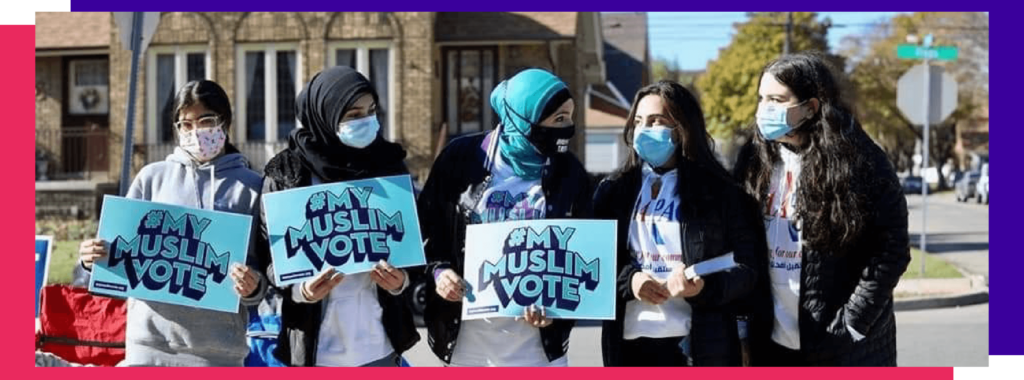
Four central themes emerged in conversations with movement partners about what is holding back the leadership and potential for political power among youth-led organizing groups. It is critical to understand these challenges to make real changes in the ways we trust, listen, and resource these groups.
Youth, especially youth of color, are often not trusted as movement leaders to govern their organizations and strategies, which often results in disproportionate levels of funding and being sidelined or silenced during strategy discussions. Even those foundations that do invest in youth-led organizations tend to see their giving as an act of charity: we are helping them, doing young people a favor, rather than investing to unlock the potential to build movements, sway elections, and develop a new generation of leaders, which in the end will help us all.
Youth leaders report that they’re often treated as an add-on or an afterthought – not a core constituency that is critical to the success of the overall movement. Youth-led organizations are invited to participate in voter registration and mobilization, but not strategy-setting sessions. Young leaders often feel tokenized, silenced, and frustrated that the establishment is failing to make deep changes or adopt the intersectional, innovative ideas they bring.
Young people of color struggle with white supremacist norms and structures within their organizations, which remain embedded in progressive social movements. Young people are aware of the gap in mentorship opportunities and real commitment from movement leaders to dismantle racist norms and implement affirmative action and equity initiatives; center program priorities around the needs of those most impacted, and provide space for young people to take on leadership positions and decision making authority.
Young leaders of color also report a shared need for capacity-building opportunities centering on organizational management, staff supervision, fundraising, and best practices for anti-racist movement building. The need for training feels especially urgent when a leader is a new, first-time executive director – and is thrown into the deep end of the pool with expectations to develop fundraising strategies, approve long and short-term plans, often while managing staff and grant-writing responsibilities for the first time. This was emphasized by young leaders of color who often endure hyper scrutiny and sky-high expectations from funders and larger organizations. In small organizations, executive directors are often recruited based on their organizing skills, connections with the community, and dedication. But they end up struggling because they’ve been hired into an organization with white supremacist ideas and must try to live up to the ideas of how to be an executive leader in a dysfunctional space without prior experience or fully appreciated for the lived experience and dynamic perspective they bring.
As a result, young leaders of color report intense levels of stress around making a mistake. Young leaders of color also report high levels of pressure to operate within, while dismantling white supremacist norms in their organizations. High turnover is common as talented young leaders struggle without supportive spaces and capacity building opportunities. Investment in shared spaces and skill-building opportunities that are to this balance of talent and leadership potential will help to close this gap between expectation and reality.
One source of serious pressure is the need to fundraise. Staff are counting on their paychecks, there are bills to be paid, and organizations often rely on a dizzying network of grants, business contributions, and individual donations to sustain their budgets. This pressure to sustain and grow funding is particularly intense for young leaders of color who come from groups that have been systematically marginalized and are less likely to have connections with foundation program officers and wealthy donors, family or friends than their white privileged peers. Yet fundraising trainings often emphasize using just these connections to identify donors and bring in money. There are not enough resources or bridges for young leaders to connect with foundation staff that hold the key to grants, support, and legitimacy. It is unbelievably difficult for youth of color to find their way into rooms they have not been invited into, and this fuels the “imposter syndrome” that many young leaders feel because they often do not move in circles with or have connections to wealthy people. They are saddled with assumptions about access to wealth, which leaves them alienated. They struggle to feel comfortable in exclusionary spaces and, as a result, end up distracted or undermined in their work.
Young people want to grow and serve their communities, but opportunities to lead at the state level are few or nonexistent. Young people of color, especially in the South, often find themselves aging out of their civic engagement groups and have to move to the West Coast or Washington D.C. or progressive urban hubs like New York City and Seattle where there are more jobs, avenues, and opportunities in order to make change.
This is a problem not only for the youth, but for the vibrancy of movements in these states. In 2022, we have yet to invest in state level infrastructure and pipelines to give leaders opportunities to keep advancing as they graduate from college and leave behind student organizing, move away from home, or age out of youth work altogether. Too often, the bulk of foundation support goes to national organizations centered in a handful of cities on the coasts. The NAVA Education Project, for example, says that when young people age out of their groups at 24, the most competent and promising leaders often get snapped up by campaigns or internships or in Washington, D.C. Local, community-based projects find it hard to compete or entice youth back home once they have made a bigger salary and lost some of their connections to home. They would love support in finding ways to hold onto young talent. There’s a real open question of how groups can provide opportunities to leaders at the upper end of the age spectrum or entice them to stay and build state and local movements.
